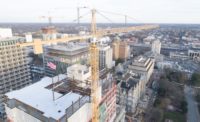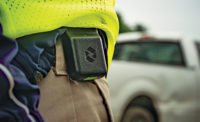Jason Tosi doesn’t fit the profile of the normal tech early adopter—his time is more focused on moving dirt. As a project superintendent of earthmoving contractor Fay, part of i+iconUSA, he’s overseen major civil engineering, infrastructure and quarrying projects across the mid-Atlantic region. But when representatives from unmanned aerial vehicle firm Identified Technologies were pitching him drones he decided to see just what they could do.
ENR spoke with Tosi about his experience using Identified Technologies drones on some of his company's bigger earthmoving projects.
When did your firm first get into using drone photography on projects?
Tosi: It started out a couple years ago, but since last April it’s been integrated into our larger earthmoving projects, and we’ve started to expand its capability beyond that of volumetric analysis.
What we’re able to do now is get a snapshot of a job, and get a picture of a job at a certain time. Since we’re able to take measurements and compare that to data, as well as measure that, and do that monthly, it gets us near-real-time data capture.
How much of the drone work are you self-performing, or are you farming it out?
We use Identified Technologies, and they provide us with the drone to fly, but they do all the backend processing. Right now if the area we’re working in is within FAA compliance, we go ahead and fly it. [Identified Technologies] does all the processing—we get a notification when it’s done and go get it from their web service. We can then look at data and download it for CAD-based analysis.
What is the largest-scale job you’ve used the drones on? Did it change how you work?
The biggest project we used it on was a quarry project in Maryland. We moved a couple million tons of rock there, and we were able to do volumetric analysis, compare data from our drone flights to what we we taking in trucks, and could see if we were over-billing or under-billing by a certain amount.
Are you finding workflow benefits from the drone photography beyond volumetric analysis?
Yeah, we’re able to use flight paths and time stamps to document issues over time, like [on one other project] we designed some drainage to be installed, we turned [the images] into a request for a change order. Instead of showing black-and-white drawings, we can overlay actual bird’s-eye view of the situation to make it easier to explain.
We can show things to an owner, and it’s better communication than noticing a few problems from the ground. We can identify a problem and find a solution much faster than in the past. I believe it helped improve some of our workflows, but I can’t really fully quantify it since it allows us to do something different than we could before.
What’s the next step for using drones on your projects, any new approaches?
Something that we’ve started experimenting with is looking at all the data the drone is providing us, and finding ways to make projects move quicker.
It’s definitely a technology that is allowing us to do what we needed to do before, but we can do it a lot safer and a lot quicker. We’re getting the information we needed for payments such as volumetric quantities or as-builts much faster.
You mentioned safety. Are the drone flights and image analysis changing your safety culture?
Before we were [using drones] there were high-traffic areas with large equipment where it was hard to see what was going on and plan around it, but now we can get that information.
Now we’re looking at larger traffic flow maps to know where the danger zones with bad visibility or high-traffic will be and have those places highlighted for our machine operators. Prior to that, it was hard to see what was around you driving on a large site. Now we have the imagery and can zoom in and see the problem areas.
Do you feel that you’ve made back you investment from the drones?
Yes, absolutely. It’s not a direct return on investment, but the data you are able to capture and store, that’s the value. Through Identified Technologies, we’ve developed a library of our projects. When we bid new jobs it lets us take a look at similar situations and the costs involved in moving a certain amount.
How many of your projects are you using the drones on right now?
We’re trying to use them on all of our jobs that involve earthwork right now, as long as [we can] comply with FAA regulations. But really anywhere: road jobs, bridges, interchanges. If it’s a large enough scale [and] we can safely fly them, we will.
It’s not invasive—we fly around work stoppages, plan flights so where a drone flying doesn’t affect anything, so there’s really no impact on the project itself. We have a few projects in couple months where we’re hoping to fly two times a week, just to see how often is practical. We’re trying to find that sweet spot. Right now we have two employees certified as drone pilots but we hope to expand that.
How have project owners responded to the drones? Do they see the value?
There is at least one project where the owner has embraced the drone and the data. We used it for payment reconciliation, working off of in-progress images. They really like the information it supplies. When we’re working out some of these RFIs , going into the trouble areas, it really helps.
I think that we’re somewhat of an early adopter, but as time goes on you’re going to see more and more of it. The reality-capture premise of getting that real time data and being able to extract the story that data is telling. The data we’re getting back is not real time, its a few hours behind. But from how it was a few years ago it’s near real time.
Any tips for other companies looking for how to use data from drones in their projects?
The greatest advice I can give is to share the data with the whole company, from young engineers to field people to senior project managers, [so] everybody can look at the data and see different things you can do with it. That sort of thing comes from a culture of sharing the information, valuing the input of employees on all levels. You’ll find unexpected benefits, from engineering, to safety, to planning and logistics.





Post a comment to this article
Report Abusive Comment